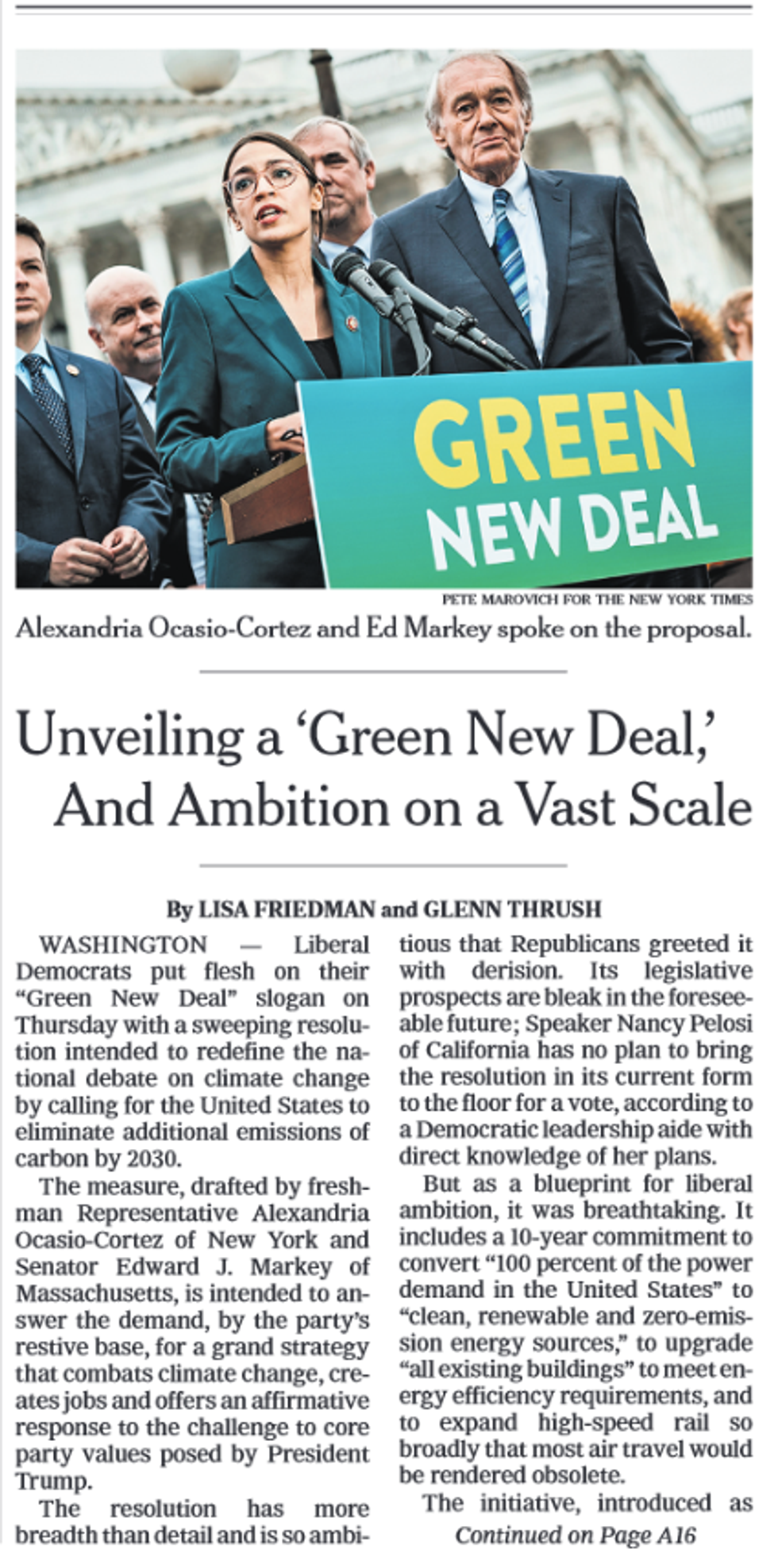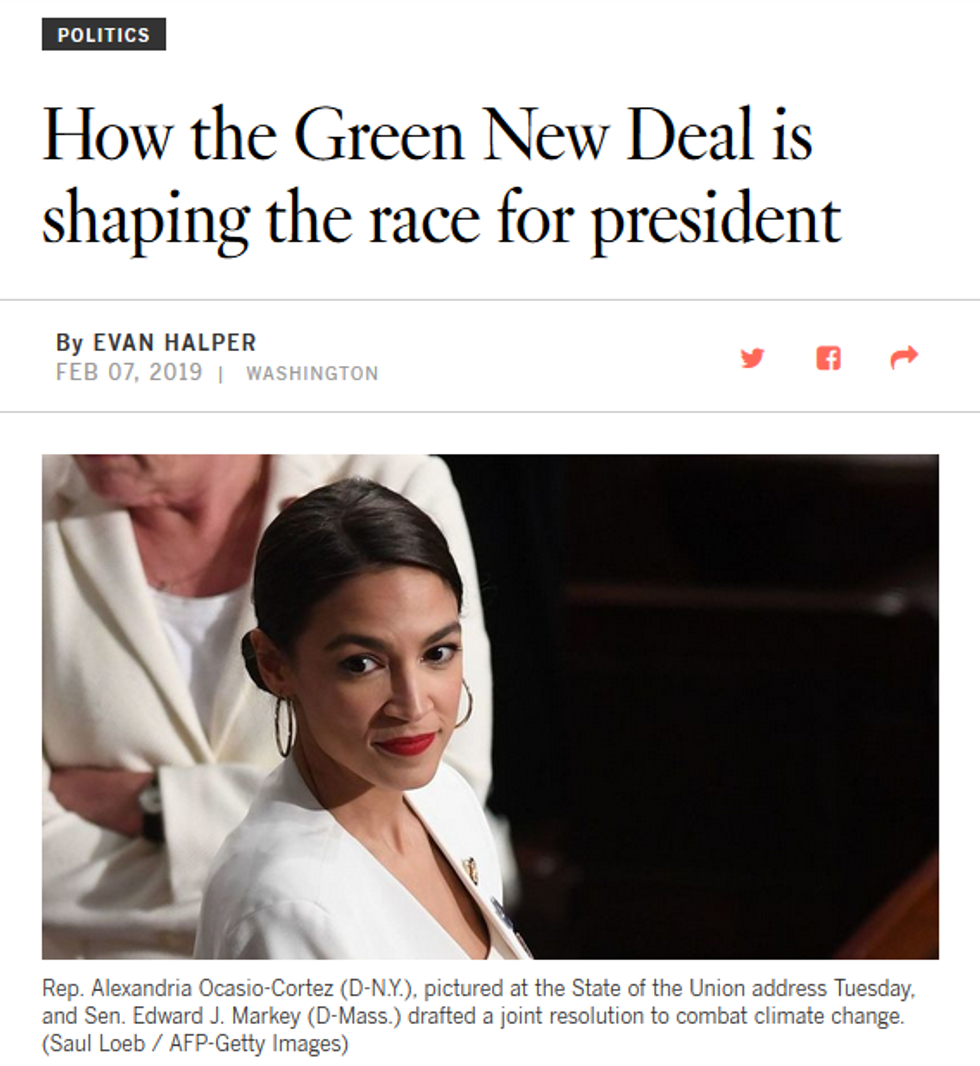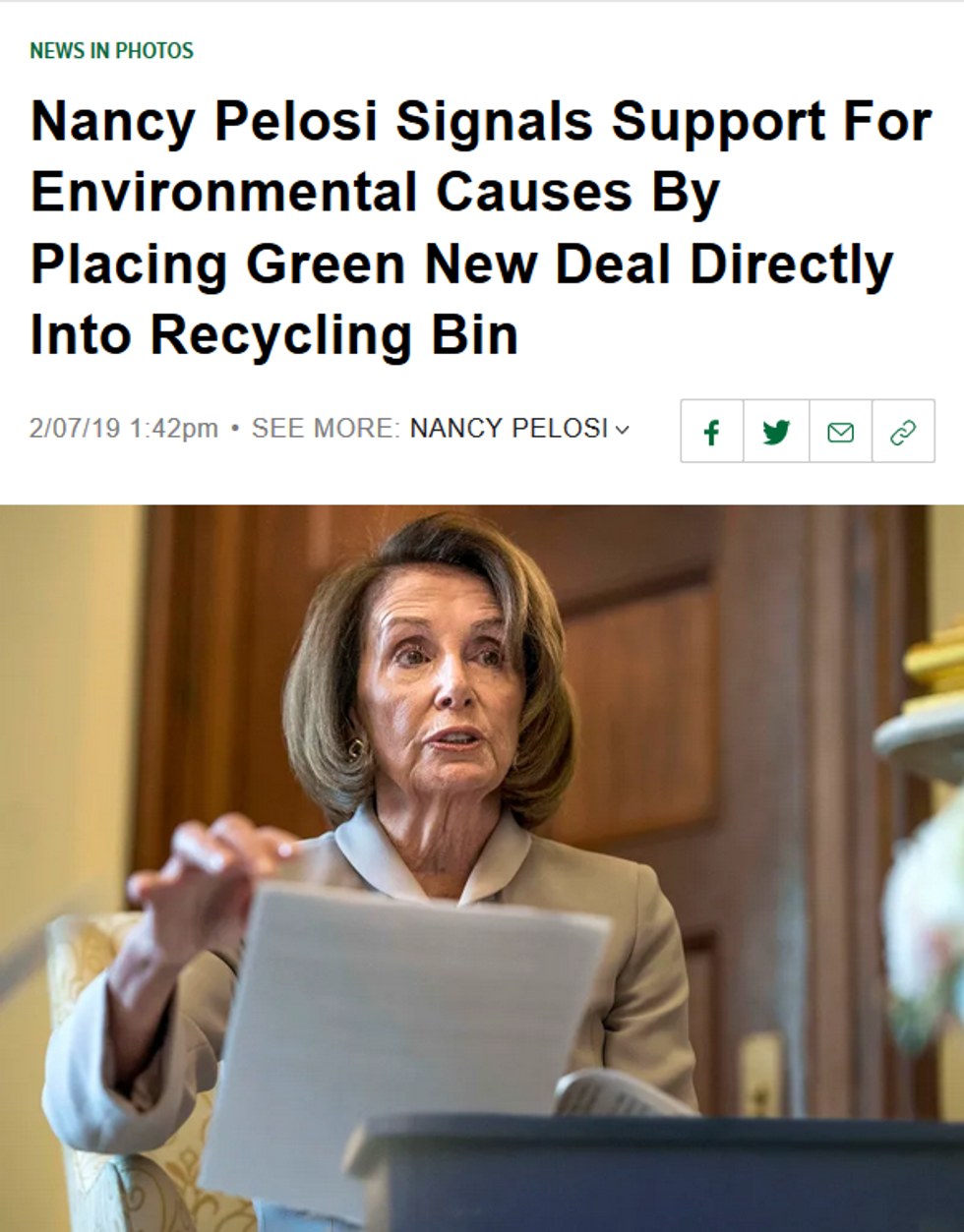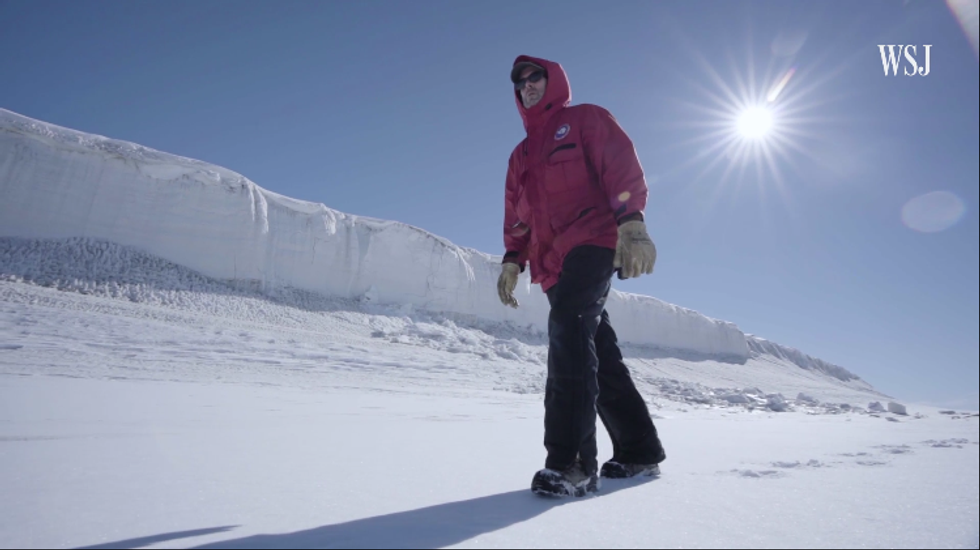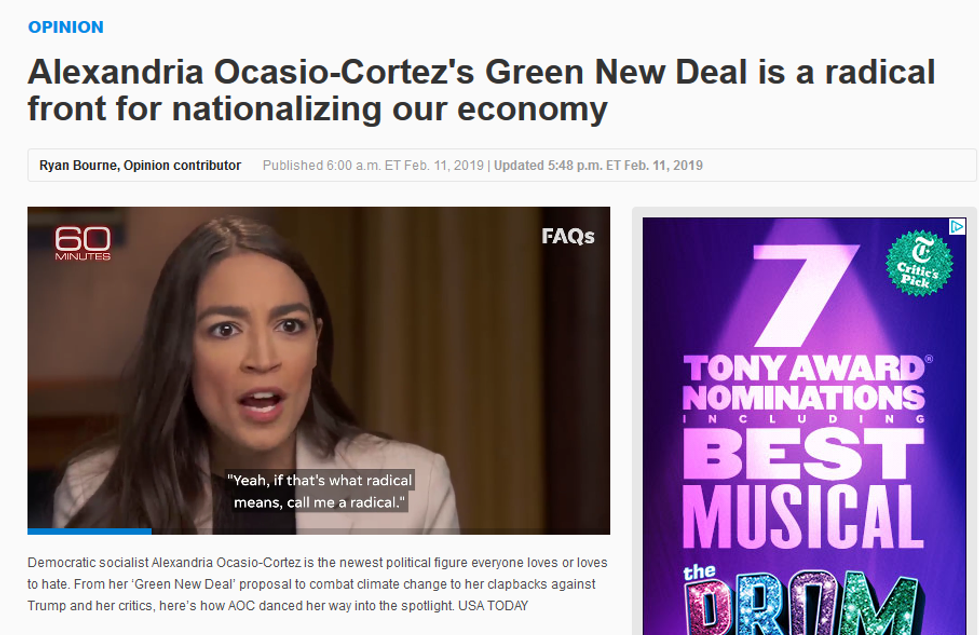Freshman Rep. Alexandria Ocasio-Cortez (known as AOC) and veteran Sen. Ed Markey on February 7 introduced HR 109, a sweeping mission statement for aggressively tackling climate change by jump-starting an equitable socio-economic transition. While the resolution was a radical departure from politics as usual, most corporate media filtered coverage of the "Green New Deal" (GND) through the lens of conventional expectations.
FAIR took a close look at day-one coverage of the Green New Deal (both breaking news stories and news analyses) across 14 major news outlets on February 7, 2019 (or, where noted, February 8): The New York Times, Washington Post, USA Today, Wall Street Journal and Los Angeles Times newspapers; the Associated Press, Reuters and UPI newswires; the CBS, NBC, ABC, CNN and Fox News networks; and NPR.
We also counted the number and nature of headlines of news and opinion pieces on the GND in the two weeks following the announcement in the papers of record (New York Times, Washington Post, Wall Street Journal), America's most-read newspaper (USA Today), and the most-watched 24/7 cable networks (CNN and Fox).
DAY 1 COVERAGE
It was hard to believe these media were all reporting on the same story, given the differences in space and time alloted it and the angles they emphasized.
Those who rely on the broadcast TV networks for their news might not have heard about the GND's release, because ABC, CBS and NBC didn't cover it on any of their broadcast shows on February 7. Nor did UPI or the Wall Street Journal print edition. The well-staffed LA Times and Washington Post relegated the news to AP's wire dispatch. (The Post even used the same headline.) The New York Times placed its 4,000-plus word news story on its February 8 front page.
Meanwhile, both CNN and Fox News' 24/7 broadcasts covered the GND all day long. CNN mostly focused on the climate science driving the GND, while the latter emphasized economics, framing the proposal alternately as a disaster and a joke.
The majority of coverage was online, where all outlets studied had at least one Day 1 story, often featuring both text and video. The New York Times, LA Times, Post, NPR and CNN also offered same-day news analyses.
News stories mostly stuck to the facts of what AOC and Markey said in their press conference and the text of the resolution itself (several online stories, to their credit, embedded the full document), followed by he said/she said reactions.
News analyses ranged from pearl-clutching over the GND's price tag and "socialist" implications (Fox) to soberly exploring its contribution to climate science and policy (CNN) to considering it as a symbolic gesture undergirded by related and unrelated political agendas (most everyone else).
Cult of Personality
The GND admittedly covers a lot of ground and leaves room for interpretation (as could be expected from a resolution, which is not a bill intended to become law but is designed to express a "sense of Congress"). One consistent news trend was a tendency to hook the ten-year plan to shorter-term, Beltway-centric hot topics. Coverage zoomed in on the resolution's lead author, Ocasio-Cortez.
Aside from the oft-mentioned five Democratic presidential candidates who endorsed it, it was easy to overlook the fact that the GND isn't just hers: It had 67 co-sponsors (now 92). About half the headlines specifically referenced AOC (often without Markey). For example: "Rep. Alexandria Ocasio-Cortez Releases Green New Deal Outline" (NPR); "'Existential' Threat to the Planet: Ocasio-Cortez Offers Green New Deal Details" (NBC online). Called a "rockstar freshman" (AP/Post/LA Times) with "media savvy...and socialist leanings [that] have catapulted her to political stardom" (LA Times), AOC is not "old enough to run for president" (CBS online); her colleague Sen. Markey joined the Senate "13 years before [she] was born" (video, CNN online).
Photos and footage of AOC dominated the imagery (again, often omitting Markey): at the mic on Capitol Hill; clad in white on the day of her swearing in; at a Women's March. Climate or energy-related visuals-melting glaciers, wildfire-ravaged communities, or even wind turbines-were seldom seen.
Partisan Politics
Indeed, stories were framed around the GND not so much as a proposal to save the planet but as a political strategy: How might the resolution, portrayed as a shift to the far left, affect the Democratic Party's power and unity? Headlines included "2020 Democrats Embrace the Green New Deal Litmus Test" (Post online) and "Alexandria Ocasio-Cortez Introduces 2020 Policy Test With Green New Deal" (CBS online). The New York Timescalled the resolution "a blueprint for liberal ambition," while another Post analysis said AOC and Markey released the resolution to "stop other Democrats from defining the Green New Deal however they wanted."
The 2020 election was a major focus. The GND "is becoming a marquee issue in the presidential race" (LA Times online); its release "signal[s] its likely elevation as a central campaign issue in 2020 despite President Trump's failure to mention climate change in his State of the Union address" (AP/Post/LA Times).
Corporate media were particularly fascinated with Nancy Pelosi's shifting take on the GND. Nearly every Day 1 story mentioned the same anecdote: that she hadn't yet read "the green dream or whatever they call it, nobody knows what it is, but they're for it, right?" as she originally told Politico (2/7/19). But she later praised the resolution's "enthusiasm," and welcomed it along with "any other proposals."
The press also frequently played up conflict between the two women. AOC--voluntarily--was not named to Pelosi's Select Committee on the Climate Crisis. But the Post's "The Fix" analysis saw fit to devote an entire article (2/7/19) to the topic. CNN even resorted to the "catfight!" trope: One segment on the GND press conference was overlaid with a tabloid-style banner teasing, "New tonight: Pelosi throws shade at Ocasio-Cortez plan as 'green dream.'"
Negative Prognosis
Any conflict was made moot, however, by the widespread media assumption that the GND was, but of course, politically dead on arrival, due to the current Republican Senate majority and the discomfort of centrist Democrats.
The New York Times warned early in its news article that the resolution's "prospects are bleak," as Pelosi "has no plan to bring [it] in its current form to the floor for a vote," later noting the House speaker's past "mistake" of pushing the 2009 cap-and-trade bill, which got Dems "swept from power." (See FAIR.org, 12/6/18, for a debunking of this myth.) A Postnews analysis the same day even quoted a headline from the Onion: "Nancy Pelosi Signals Support for Environmental Causes by Placing Green New Deal Directly into Recycling Bin." (While Pelosi would play a key role in if and how the resolution's multiplicity of ideas might be implemented, so would committee chairs, and constituents such as state leaders and even grassroots activists.)
The Washington Post had a news analysis headlined, "The Green New Deal Is Generating Lots of Left-Wing Enthusiasm. But Not Every Democrat Is on Board." (Original title: "Green New Deal Sparks Immediate Democratic Divisions.") The piece referred to the resolution's "impossible-to-achieve goals." NPR's Danielle Kurtzleben noted off the bat that "the chances for this plan in Congress are slight," also declaring, "There is virtually zero chance it will pass this Congress."
The resolution was also portrayed as technically unfeasible. The Post's news analysis sighed that while "electricity from renewable sources has grown precipitously...few experts think that figure can get to 100 percent any time soon." NPR followed its news story with an interview with former Energy Secretary Ernest Moniz, who dismissed the resolution's clean-energy goals as "impractical" and "unrealistic," worrying that "we cannot strand too many assets" and "jeopardize...the very significant movement of large energy companies toward developing their new business models." (Moniz is CEO of Energy Futures Initiative, a think tank with a large corporate presence on its board.) Not all experts see ramping up to a decarbonized energy system as impossible, though, as an article in Popular Science showed a few weeks later ("The Green New Deal Is More Feasible Than You Think," 2/27/19).
And then there was the financial cost. Here, outlets utilized the standard "economy vs. environment" framing, remarking that the GND's cost and funding source were a troubling mystery, or claiming that the cost would be astronomical and paid for by "big government." As the AP story picked up by the Post and the LA Times put it, "GOP lawmakers denounce the plan as a radical proposal that would drive the economy off a cliff and lead to huge tax increases." NPR political editor Domenico Montanaro told Morning Edition host Steve Inskeep, "This costs trillions and trillions of dollars. I mean, the fact is that people want to know how much their energy bill is going to be each month."
Price tags were provided mainly by Republican opponents of the plan, whose sources of information weren't questioned. The notion of financial ruin was "balanced" by quotes from AOC or Markey that this 21st century Moon Shot would be worth the investment, but no outlets offered any concrete calculations either way.
Stories were also sprinkled with name-calling unworthy of a serious debate. Fox News' Melissa Francis and guest James Freeman called the plan "terrifying" and "kooky," respectively. Outlets chose to cite politicians who called it "cute" (Journal), "communist doctrine" (CNN) and "a socialist manifesto" (the oft-quoted Sen. John Barrasso, chair of the Senate Environment and Public Works committee, who was mentioned by the Journal, Post, LA Times, USA Today, Reuters, NBC and AP).
There were also factual errors regarding the resolution's purpose and contents. Many outlets took the aspirational, non-binding document (which AOC has called "a request for proposals") as a non-negotiable demand. CNN and Fox online referred to it as "legislation." (It's a non-binding resolution, which most media made clear.) The plan would not fully eliminate "US greenhouse gas emissions" (Reuters), but calls for net-zero emissions, meaning carbon sources would be offset by carbon sinks such as trees or even carbon capture-and-storage. Fox News online asked "what type of energy the country would rely on instead of greenhouse gases"--which are the result of burning fuels, not fuels themselves.
Giving Climate Science Short Shrift
Day-1 stories about the GND typically originated from the politics, business or foreign desks. For the most part, the resolution's primary drivers -climate science and the need for equitable climate policy--were engaged with only briefly.
For example, while a few pieces mentioned the dire findings of the most recent IPCC report or National Climate Assessment (some at the beginning, others much further down), many barely addressed objective climate facts, simply quoting from AOC and Markey's announcement or other press materials as if earth's "existential crisis" was merely their opinion.
Moreover, few of the understandable concerns about GND's broad scope and rapid timetable were viewed in context of the urgency of climate action. As for the economic and social goals of the resolution, reports treated clean air and water, sustainable agriculture, healthcare for all and equity for frontline communities as peripheral, a classic progressive wish-list. Whereas the causes and impacts of climate change are closely linked to all of these issues. For example, the medical journal the Lancet (5/16/09) has called climate change "the biggest global health threat of the 21st century."

A few outlets did offer significant discussion of the climate crisis. USA Today's piece ("Green New Deal: What Is It and What Does It Mean for Climate Change?") featured a Q&A whose queries and replies provided context and nuance about both the state of climate science and how the resolution might reach its goals. The Journal's otherwise electoral politics-centric article featured a nine-minute-plus mini-documentary with a climate scientist in Antarctica.
Overall, CNN deserves plaudits for its aggressive, all-day coverage, which was not only science-centric but actively engaged with the tenets of the GND. For example, correspondent Bill Weir's "deep dive" compared it favorably with FDR's New Deal:
Let's pay 2 million guys to plant trees out west, build dams and roads and all of that. They gave us labor unions and unemployment insurance and Social Security, the things that changed the way people think about government. This is the modern version of that. Let's do all of those things again, only smarter and non-polluting.
Of AOC, Weir commented, "At the very least, she'll have people talking about the potential end of the world, and maybe that's not a bad thing."
SUBSEQUENT COVERAGE
In the two weeks following the GND's big reveal, the Washington Post, CNN and Fox continued to regularly cover and publish opinion about it. While the cable news networks focused mostly on news, the Post published 28, mostly negative, opinion pieces (versus 18 news stories). Coverage was relatively light at the Times (seven news stories, five opinion, with the opinion pieces mostly ambivalent), the Journal (two news, eight opinion, the opinion all negative) and USA Today (two news and two opinion, both negative).
Pieces on political gamesmanship, "realism" and Democratic Party politics continued to be favorite subjects, as did economy-vs.-environment themes such as job loss (despite the fact that the GND was designed as a green job-creation plan), its high price tag and a continued need for fossil fuels.
Some opinion pieces tried to foment a red scare, positioning the GND and an ambitious climate-care agenda as "a stalking horse for socialism." A February 16 piece by former Reagan speechwriter Peggy Noonan in the Journal was headlined, "Republicans Need to Save Capitalism." USA Today had an essay by Ryan Bourne of the Cato Institute calling the GND "a Trojan horse" for "socializing the economy."
The number of news or opinion pieces focused on climate science and policy was low, especially--and unsurprisingly--in the Journal and on Fox.
But these tended to look favorably on the GND, seriously engaging with how elements of the plan might be implemented. At CNN online, former National Security Council member Alice Hill argued for the need to build resilient infrastructure ("The Part of the Green New Deal We Should All Support," 2/14/19). And in "The Green New Deal's Realism" (New York Times, 2/16/19), Jedediah Britton-Purdy declared that the resolution's:
everything-and-the-carbon-sink strategy is actually a feature of the approach, not a bug.... In the 21st century, environmental policy is economic policy. Keeping the two separate isn't a feat of intellectual discipline. It's an anachronism.
This sort of discussion is exactly what the resolution was intended to kickstart.
Changing the News Climate
Today, more than two months in from the GND's introduction, the resolution itself has stalled. On March 26, Majority Leader Mitch McConnell brought it up for a vote sans discussion or debate, with most Dems abstaining.
But ambitious climate policymaking is happening, with GND-like state- and city-level climate programs being crafted in, for example, Rhode Island and Los Angeles. A record number of congressional hearings on climate change have been held in recent weeks, or are scheduled.
As several outlets studied noted in passing, large majorities of Americans say they want aggressive action on climate change. According to the LA Times (2/7/19):
A recent poll by Yale and George Mason University found the idea of a Green New Deal has the support of 81 percent of registered voters, including nearly two-thirds of Republicans.
To meet that level of public concern, the mainstream media should be covering how to leverage climate action quickly and broadly enough to make a dent in the crisis, as well as probing how and if solutions can also bring a clean and just energy economy into existence.


